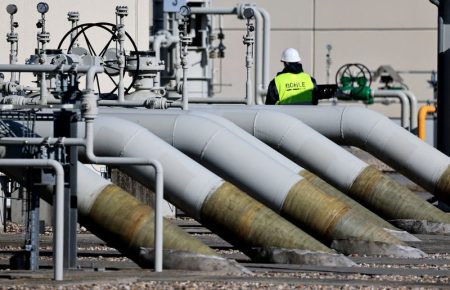By Shariq Khan
NEW YORK (Reuters) -Oil prices rose 1% on Wednesday as geopolitical tensions raged on in the Middle East and traders assessed signs of near-term supply tightness.
U.S. West Texas Intermediate crude futures (WTI) rose 87 cents, or 1.1%, to settle at $77.91 a barrel, while rose 69 cents, or 0.8%, to $83.03 a barrel.
Oil contracts tied to near-term deliveries have been trading at their steepest premium to later-dated contracts in multiple months, a market structure known as backwardation and considered a sign of a tightly supplied market.
Timespreads are showing markets tightening, UBS analyst Giovanni Staunovo said, adding that crude stocks declined in the Amsterdam-Rotterdam-Antwerp trading hub while product stocks slid in Fujairah last week.
Also supporting the market, U.S. refineries are showing signs of returning from maintenance after slumping to their lowest operating rates since December 2022, spurring builds in crude stockpiles.
“Recent refinery outages led to some crude oil builds across the globe but these could be coming back online, which will put pressure on crack spreads and could support more crude usage,” said Alex Hodes, energy analyst at StoneX.
Analysts expect U.S. refinery runs to have risen by 0.9 percentage point last week from 80.6% of total capacity in the previous week, according to a Reuters poll. stocks likely rose last week by nearly 4 million barrels last week, the poll showed.
Figures from the American Petroleum Institute showed a larger 7.17 million barrel build in U.S. crude stocks, market sources said. [API/S]
Official data from the Energy Information Administration is due at 11 a.m. ET on Thursday, delayed a day by Monday’s U.S. holiday.
Houthi attacks on commercial vessels in the Red Sea and Bab al-Mandab strait have continued to stoke concerns over freight flows through the critical waterway. Drone and missile strikes have hit at least four vessels since last Friday.
The U.S. Federal Reserve is concerned about cutting rates too soon, minutes of its January policy meeting showed. Traders of U.S. short-term interest-rate futures stuck to bets the U.S. Federal Reserve will begin cutting interest rates no earlier than June.
Concerns that rate cuts by the Fed could take longer than thought have been weighing on the outlook for oil demand. U.S. inflation data last week pushed back expectations for an imminent start to the Fed’s easing cycle.
Read the full article here









